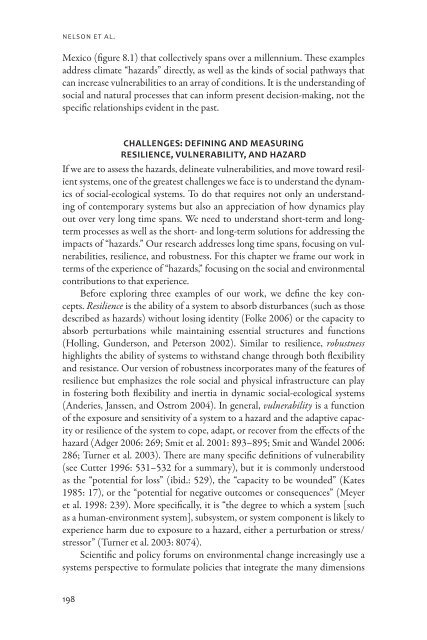free download - University Press of Colorado
free download - University Press of Colorado
free download - University Press of Colorado
You also want an ePaper? Increase the reach of your titles
YUMPU automatically turns print PDFs into web optimized ePapers that Google loves.
Nelson et al.<br />
Mexico (figure 8.1) that collectively spans over a millennium. These examples<br />
address climate “hazards” directly, as well as the kinds <strong>of</strong> social pathways that<br />
can increase vulnerabilities to an array <strong>of</strong> conditions. It is the understanding <strong>of</strong><br />
social and natural processes that can inform present decision-making, not the<br />
specific relationships evident in the past.<br />
Challenges: Defining and Measuring<br />
Resilience, Vulnerability, and Hazard<br />
If we are to assess the hazards, delineate vulnerabilities, and move toward resilient<br />
systems, one <strong>of</strong> the greatest challenges we face is to understand the dynamics<br />
<strong>of</strong> social-ecological systems. To do that requires not only an understanding<br />
<strong>of</strong> contemporary systems but also an appreciation <strong>of</strong> how dynamics play<br />
out over very long time spans. We need to understand short-term and longterm<br />
processes as well as the short- and long-term solutions for addressing the<br />
impacts <strong>of</strong> “hazards.” Our research addresses long time spans, focusing on vulnerabilities,<br />
resilience, and robustness. For this chapter we frame our work in<br />
terms <strong>of</strong> the experience <strong>of</strong> “hazards,” focusing on the social and environmental<br />
contributions to that experience.<br />
Before exploring three examples <strong>of</strong> our work, we define the key concepts.<br />
Resilience is the ability <strong>of</strong> a system to absorb disturbances (such as those<br />
described as hazards) without losing identity (Folke 2006) or the capacity to<br />
absorb perturbations while maintaining essential structures and functions<br />
(Holling, Gunderson, and Peterson 2002). Similar to resilience, robustness<br />
highlights the ability <strong>of</strong> systems to withstand change through both flexibility<br />
and resistance. Our version <strong>of</strong> robustness incorporates many <strong>of</strong> the features <strong>of</strong><br />
resilience but emphasizes the role social and physical infrastructure can play<br />
in fostering both flexibility and inertia in dynamic social-ecological systems<br />
(Anderies, Janssen, and Ostrom 2004). In general, vulnerability is a function<br />
<strong>of</strong> the exposure and sensitivity <strong>of</strong> a system to a hazard and the adaptive capacity<br />
or resilience <strong>of</strong> the system to cope, adapt, or recover from the effects <strong>of</strong> the<br />
hazard (Adger 2006: 269; Smit et al. 2001: 893–895; Smit and Wandel 2006:<br />
286; Turner et al. 2003). There are many specific definitions <strong>of</strong> vulnerability<br />
(see Cutter 1996: 531–532 for a summary), but it is commonly understood<br />
as the “potential for loss” (ibid.: 529), the “capacity to be wounded” (Kates<br />
1985: 17), or the “potential for negative outcomes or consequences” (Meyer<br />
et al. 1998: 239). More specifically, it is “the degree to which a system [such<br />
as a human-environment system], subsystem, or system component is likely to<br />
experience harm due to exposure to a hazard, either a perturbation or stress/<br />
stressor” (Turner et al. 2003: 8074).<br />
Scientific and policy forums on environmental change increasingly use a<br />
systems perspective to formulate policies that integrate the many dimensions<br />
198





